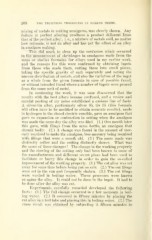Page 634 - My FlipBook
P. 634
308 THE TECHNICAL PROCEDURES IN FILLING TEETH.
mixing of metals in making amalgams, was clearly shown. Any
failure in perfect alloying produces a product different from
that of the perfect alloy; i. e., a mixture of metals cold, no matter
how intimate, is not an alloy and has not the effect of an alloy
in amalgam making.
This did much to clear up the confusion which occurred
in the measurement of shrinkages in amalgams made from the
same or similar formulas for alloys used in my earlier work,
and the reasons for this were confirmed by obtaining ingots
from those who made them, cutting these into small pieces,
taking the specific gravity of each separately and noting the
uneven distribution of metals, and also the variation of the ingot
as a whole from the given formula in case of possible fraud,
or without intended fraud where a number of ingots were poured
from the same melt of metal.
In continuing the work, it was soon discovered that the
results with the best alloys became confused, and a review and
careful posting of my notes established a curious line of facts.
A silver-tin alloy, particularly silver 65, tin 35 (this formula
will often have to be modified to obtain accurate results), made
in hydrogen in the closed electric crucible, gave an amalgam that
gave no expansion or contraction in setting when the amalgam
was made the same day the alloy was filed. (1.) One month later
this gave, with filings from the same bottle, an amalgam that
shrunk badly. (2.) A change was found in the amount of mer-
cury required to make the amalgam, less mercury being required
with filings that were a month old. (3.) The mass made was
distinctly softer and the setting distinctly slower. What was
the cause of these changes ? The change in the working property
and the slowing of the setting only had been known to some of
the manufacturers and different secret plans had been used to
facilitate or hurry this change in order to gain the so-called
improvement of the working property. (1.) The cut alloy was set
away for some time before being put on sale. (2.) The cut filings
were set in the sun and frequently shaken. (3.) The cut filings
were washed in boiling water. These processes were known
as aging the alloy. It could not be done in the ingot. It had to
be done after the alloy was cut.
Experiments carefully recorded developed the following
facts: (1.) The full change occurred in a few moments in boil-
ing water. (2.) It occurred in fifteen minutes by placing the
cut alloy in a test tube and placing this in boiling water. (3.) The
same result was obtained by subjecting it fifteen minutes to


